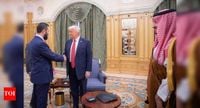In a diplomatic development that has sent ripples across the Middle East and beyond, President Donald Trump is set to welcome Syrian President Ahmad al-Sharaa to the White House on November 10, 2025. This unprecedented visit, confirmed by multiple administration officials, marks the first time a Syrian head of state will set foot in the White House—a striking signal of shifting alliances and new possibilities in a region long defined by instability and suspicion.
The news, first reported by Axios and subsequently confirmed by outlets including Business Standard and The Hindu, comes at a moment when Syria is emerging from decades of international isolation. The country, still reeling from the more than fifty-year iron rule of the Assad family, is now led by al-Sharaa, a figure whose past is as turbulent as the nation he governs.
Al-Sharaa, who seized power in December 2024 following a rapid offensive that ended Bashar al-Assad’s reign, is no stranger to controversy. Under the alias Abu Mohammed al-Golani, he was once a senior commander in Hayat Tahrir al-Sham, a group designated as a terrorist organization by the United States. His ties to al-Qaida and participation in insurgencies against U.S. forces in Iraq earned him a $10 million bounty and years in U.S. military detention during the Syrian civil war. As Business Standard notes, “Al-Sharaa once had a $10 million US bounty on his head.”
Despite his checkered history, al-Sharaa has sought to rebrand himself as a reformer since assuming the presidency. He has held high-profile meetings with world leaders, including French President Emmanuel Macron and, notably, President Trump during a summit in Riyadh in May 2025. That encounter was itself historic: the first meeting between U.S. and Syrian leaders in a quarter-century, dating back to Hafez Assad’s summit with Bill Clinton in Geneva in 2000.
The upcoming White House meeting is not just a diplomatic photo-op. According to U.S. Special Envoy to Syria Tom Barrack, who spoke at the Manama Dialogue in Bahrain, the visit aims to “strengthen cooperation against ISIS and advance peace efforts between Syria and Israel.” The U.S. hopes Syria will formally join the coalition against ISIS, a move Barrack described as “a huge step for Damascus.” As The Hindu puts it, “Al-Sharaa is expected during his visit to sign an agreement on joining the U.S.-led coalition against ISIS.”
This potential alliance comes at a crucial time. The U.S.-led coalition, formed in 2014, succeeded in dismantling ISIS’s territorial control by 2019. Yet, recent intelligence suggests the group is attempting a resurgence in the power vacuum left by Assad’s ouster. Al-Sharaa, once associated with an Al Qaeda offshoot, is now positioned as a key figure in the effort to stabilize post-Assad Syria. According to Business Standard, “The meeting marks a major turn of events for Syria, adjusting after over 50 years of Assad family rule.”
But the significance of al-Sharaa’s visit extends beyond counterterrorism. The U.S. is quietly encouraging Syria to finalize a security agreement with Israel before the Washington summit. Barrack confirmed that Syria and Israel have been engaged in U.S.-mediated de-escalation talks, with a potential deal reportedly close to completion. The agreement could pave the way for an end to Israeli airstrikes in Syria and the withdrawal of Israeli forces from the country’s south—developments that, if realized, would mark a dramatic shift in the regional balance of power.
These diplomatic overtures are taking place against a backdrop of ongoing volatility. The region remains tense following a fragile ceasefire and hostage deal brokered between Israel and Hamas, which took effect on October 10, 2025. While the truce has largely held, it was recently tested by a devastating round of Israeli airstrikes in Gaza that killed 104 people, including dozens of women and children. Israeli officials attributed the strikes to Hamas’s killing of a soldier and a disputed hostage situation, underscoring just how precarious the peace remains. As The Hindu reported, “The strikes were the deadliest since the ceasefire began and were in response to Hamas killing a soldier and staging the discovery of a deceased hostage.”
For Syria, the stakes are high. The country is still under United Nations sanctions, and its government faces accusations of sectarian violence, particularly against Druze and Alawite minorities. These allegations have cast a shadow over al-Sharaa’s attempts to present himself as a unifying and reform-minded leader. Nevertheless, he has pledged to rebuild Syria as a “safe, stable, and unified” nation—a promise met with both hope and skepticism by observers at home and abroad.
Adding to the complexity is the issue of U.S. sanctions. The Trump administration has indicated support for Congress to permanently remove the so-called Caesar sanctions, a set of restrictions imposed in 2020 targeting the Assad regime and its business partners. While the administration has issued temporary waivers, only Congress can vote to lift the sanctions permanently. The Caesar Syria Civilian Protection Act, named after a Syrian military defector who exposed evidence of torture, remains one of the most stringent measures in place against Syria. Easing these sanctions would be a significant carrot for al-Sharaa’s government and could further incentivize cooperation on security and peace-building initiatives.
There’s also the matter of regional diplomacy. The last visit to the White House by a senior Syrian official occurred in December 1999, when then-Foreign Minister Farouq al-Sharaa attended peace talks with Israel. The upcoming summit is expected to be followed by a fifth round of U.S.-mediated negotiations between Israel and Syria, with the goal of reaching a security agreement on their shared border by year’s end, according to Barrack.
Despite his efforts to project a new image, al-Sharaa’s past remains a source of concern for Western governments. His rise to power unsettled many in Washington and Europe, wary of his previous ties to jihadist groups. Yet, the calculus appears to be shifting: the prospect of integrating Syria into a broader regional security framework, and the hope of finally putting an end to the cycles of violence that have plagued the region, are powerful incentives for engagement.
As the world watches, the November 10 summit between Trump and al-Sharaa stands as a potential inflection point. If successful, it could mark the beginning of a new era in U.S.-Syria relations and perhaps—just perhaps—offer a glimmer of hope for a region long in search of lasting peace.





